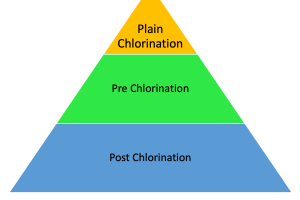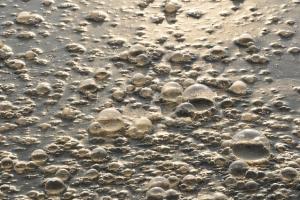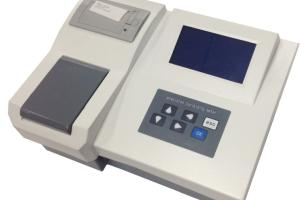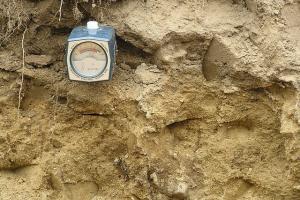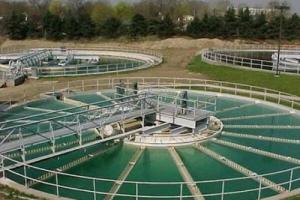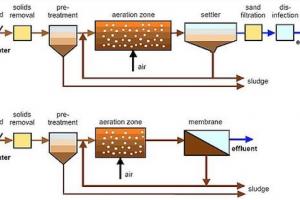Preliminary Treatment of Waste Water

Preliminary treatment of wastewater consists of the following steps:
- Screening
- Comminution
- Grit Removal
- Flow Equalization
- Oil and Grease Removal
- Pre-Aeration
1. Screening
The first unit operation generally encountered in wastewater treatment plants is screening. A screen is a device with openings, generally of uniform size, that is used to retain solids found in the influent wastewater to the treatment pant. The principal role of screening is to remove coarse materials (pieces of wood, plastics, rags, papers, leaves, roots etc.) from the flow stream that could:
- Damage subsequent process equipment e.g. pumps, valves, pipe lines, impellers.
- Reduce overall treatment process reliability & effectiveness, or
- Contaminate waste way
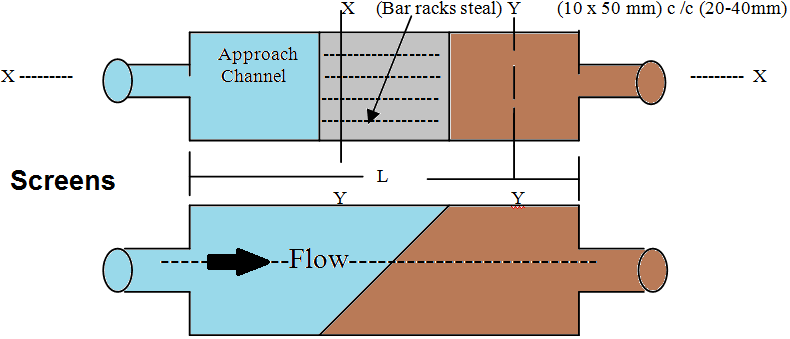
Design of screening chamber:
The objective of screens is to remove large floating material and coarse solids from wastewater. It may consist of parallel bars, wires or grating placed across the flow inclined at 30o-60o. According to method of cleaning; the screens are hand cleaned screens or mechanically cleaned screens. Whereas, according to the size of clear opening, they are coarse screens (≥ 50 mm), medium screens (25-50 mm) and fine screens (10-25 mm). Normally, medium screens are used in domestic wastewater treatment.
Dimensions of an approach channel
Used in wastewater treatment is mostly rectangular in shape. Wastewater from the wet well of the pumping station is pumped into the approach channel from where it flows by gravity to the treatment plant. Its main function is to provide a steady and uniform flow after pumping.
- Select the size of bar/clear opening, say 10mm x 10 mm (medium screens)
- No. of bars; {(n + 1) + (n) = B}, and {Be = B – (width of bar)(n)}
- Head loss, hL = 0.0729 (V2 – Vh2) ------ {Vh 0.75m/sec, hL ≤ 0.5 ft}
- For perforated plate; amount of screening produce = (1-2) ft3/MG
- Length of bar; L = D/sinθ, and Lh = L * cosθ.
- Screen chamber. Lc = inlet zone (2-3 ft) + Lh + outlet zone {outlet zone = width of p plate + (0.5-1.0 ft)}
2. Wastewater treatment through Coarse Solids Reduction:
As an alternative to coarse bar screens or fine screens, communitors and macerators be use to intercept coarse solids and grind or shred them in the screen channel. High – speed grinders are used in conjunction with mechanically cleaned screens to grin and shred screenings that are cit up into a smaller, more uniform size for return to the flow stream for subsequent removal by downstream treatment operations and processes, communitors, macerators and grinders can theoretically eliminate the messy and offensive task of screening handling and disposal.
Comminutors – small WWT (0.2 m3/s or 5 MGD) 6 - 20 mm (0.25 N 0.77in)
a. Comminutors:
Comminutors are used commonly in small wastewater treatment plants having discharge less than (0.2m3/s or 5MGD). They are installed in a wastewater flow channel to screen and shred material to sizes from 6 to 20 mm (0.25 to 0.77 in) without removing the shredded solids from the flow stream. It cuts them to a relatively uniform size and prevents the solids from freezing/clogging in the flow.
Comminutors are always placed before the grit chamber to reduce wear and tear occurring on the surfaces.
b. Macerators:
Macerators are slow speed grinders that typically consist of two sets of counter rotating assemblies with blades. The assemblies are mounted vertically in the flow channel. The blades or teeth on the rotation assembles have a close tolerance that effectively chop material as it passes through the unit.
c. Grinders:
High speed grinders typically referred to as fiammermills, receive screened materials from base screen. The materials are pulverized by a high speed rotation assembly that wets the materials passing through the unit.
3. Grit Removal system from Wastewater:
It is a Unit operation (physical). Removal of grit form waste Swater may be accomplished in grit chambers or by centrifugal separation of solids. Grit chambers are designed to remove grit, consisting of sand, gravel, sanders, or other heavy solid materials that have specific gravities or setting velocities substantially greater than those of organic particles in wastewater. Grit chambers are most commonly located after the bar screens and before the primary sedimentation.
These are just like sedimentation tanks, design mainly to remove heavier particles or coarse inert and relatively dry suspended solids from the wastewater. There are two main types of grit chambers like rectangular horizontal flow types and aerated grit chambers. In the aerated grit chamber the organic solids are kept in suspension by rising aerted system provided at the bottom of the tank.
Purpose of Grit Chamber
Grit chambers are provided to:
- Protect moving mechanical equipment from abrasion and accompanying abnormal wear.
- Reduce formation of heavy deposits in pipelines, channels and conduits.
- Reduce the frequency of digester.
Flow Equalization tank
Flow equalization is method used to overcome the operational problems and flow rate variations to improve the performance of downstream processes and to reduce the size & cost of downstream treatment facilities. To prevent flow rate, temperature, and contaminant concentrations from varying widely, flow equalization is often used. It achieves its objective by providing storage to hold water when it is arriving too rapidly, and to supply additional water when it is arriving less rapidly than desired. A smaller the screen opening, greater will be the amount of material screened.

In order to improve the performance of a reactor, particularly the biological processes, it is required to equalize the strength of wastewater and to provide uniform flow, an equalization tank is design after screen and grit chamber. This may be in the line-off or off-line, as shown in the figure;
5. Primary Sedimentation Tank
Sedimentation or setting tanks that receive raw wastewater prior to biological treatment are called primary tanks. The objective of the primary sedimentation tank is to remove readily settleable organic solids and floating material and thus reduce the suspended solid content. Efficiently designed and operated primary sedimentation tanks should remove from 50 to 70% the suspended solids and 25 to 40% of the BOD.
Sedimentation is carried out in variety of tank configurations including:
- Circular sedimentation tank
- Rectangular sedimentation tank
- Square sedimentation tank
Primary sedimentation is among the oldest wastewater treatment process. Traditionally the design criteria for sizing setting tanks are:
Average overflow rate: 30 - 50 m3/m2/d (Typical 40 m3/m2/d) [800-1200 gal/ft2-d (Typical 1000 gal/ft2-d]
Peak hourly overflow rate: 50 - 120 m3/m2/d (Typical 100 m3/m2/d) [2000-3000 gal/ft2-d (Typical 2500 gal/ft2-d]
Weir loading rate: 1.5 - 2.5h (Typical 2.0 h) [1.5 - 2.5 h (Typical 2.0h)]




